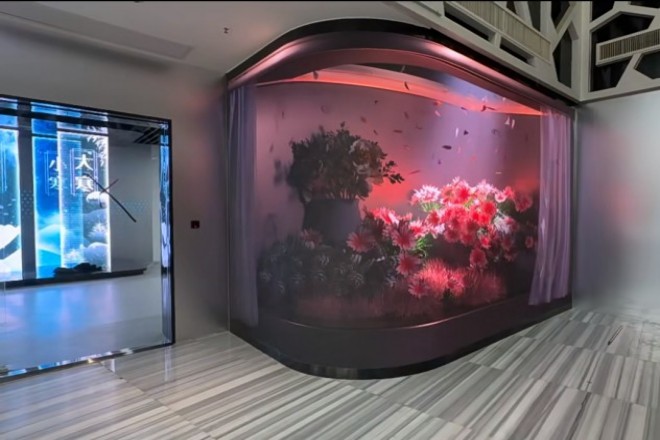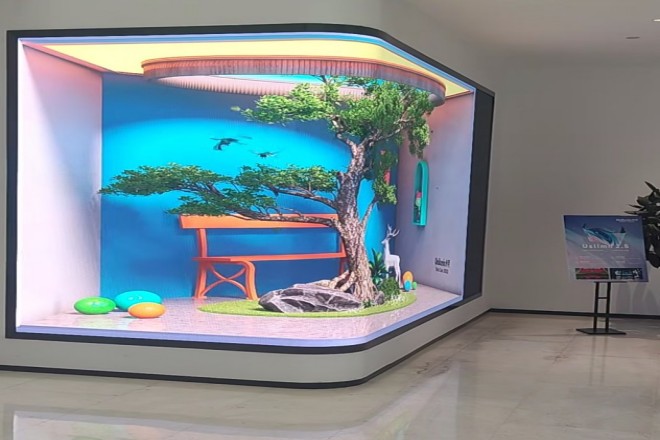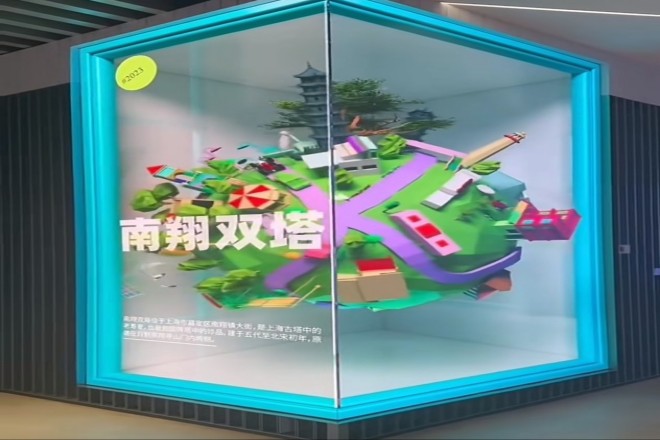Introduction
Have you seen indoor Écrans d'affichage LED 3D? Yes! 3D LED display screens can be installed not only outdoors but also indoors.
But what should be paid attention to when installing 3D LED display screens indoors? This article will explain the key points in detail to help ensure efficient and stable operation and the best display effect for your indoor 3D LED display screen.
1. Pay attention to the adaptability of the indoor environment

1). Space layout:
You need to think about where the audience can stand to watch your 3D LED display screen most comfortably. Too close, the eyes are tired; too far, the 3D effect is gone. Generally speaking, 1.5 to 2 times the diagonal length of the screen is just right.
The viewing angle is also very important! The screen should be tilted slightly downward so that both tall and short people can enjoy a balanced 3D visual feast. Don’t let everyone look up; how tiring it is!
But one thing you need to pay attention to is that your 3D LED display is installed indoors, so whether your indoor installation site can meet your needs; if not, then in order to achieve good display and visual effects, you have to change the installation location.
- Reflection and interference all go away:
Light and sunlight, these guys are the “natural enemies” of 3D screens. You have to find a place without direct light sources to install the screen or draw the curtains to make the reflections nowhere to hide.
If the ambient light is too strong, add some soft lights around the screen to balance the light and make the audience’s eyes more comfortable.
2). Temperature and humidity management:
- Constant temperature and humidity, the screen loves it most:
Did you know? 3D LED display screens are also like the “comfort zone.” That is, the temperature is kept at 20-25℃, and the humidity is 40%-60% so that it can work steadily and have a long life.
In large shopping malls or exhibition halls, it is most convenient to use central air conditioning to adjust the temperature and humidity. Remember to check the air conditioning effect regularly, and don’t let the screen “heat” or “moisture.”
- Moisture-proof and ventilation are indispensable:
Moisture is the “enemy” of electronic devices. You have to ensure that the room is well-ventilated, open windows regularly for ventilation, or use a ventilation system to help. In humid seasons, a dehumidifier is a good helper. It can reduce indoor humidity and protect the screen from moisture.
2. Pay attention to the characteristics of 3D display technology
If you want your 3D LED display to explode, you have to think about the ins and outs of 3D display technology. Don’t rush to install it; take a look at these two key points first, and make sure your screen shines!
1). Viewing angle optimization:
- You have to adjust the screen tilt angle:
The 3D effect cannot be achieved by just placing a screen. According to the principle of the 3D display, the screen tilt angle must be adjusted to be parallel to the viewer’s line of sight so that the three-dimensional effect is stronger, as if everything in the picture is about to jump out!
- Multi-viewing angle design to take care of every audience:
Considering that the audience in indoor venues may come from different directions, a single-viewing angle 3D display may not meet the needs of all audiences. Therefore, you can adopt a multi-viewing design by adjusting the screen structure or using special optical technology to ensure that no matter where the audience stands, they can get a good 3D experience.
2). Résolution et fréquence de rafraîchissement:
- High-resolution, more delicate picture:
If the pixels on the screen are clearly visible, how delicate the picture must be! Therefore, choosing a high-resolution LED screen can reduce the graininess of the picture and make the 3D effect more realistic.
- High refresh rate, say goodbye to ghosting:
The refresh rate is the key to determining the smoothness of the picture. If the refresh rate is too low, the picture will have ghosting, which is uncomfortable to watch. Therefore, you have to choose a screen with a high refresh rate so that the picture can be as smooth as silk, allowing the audience to immerse themselves in the 3D world.
3). Practical tips:
- Field testing is indispensable:
Don’t just listen to me; you have to test it in the field. Install the screen, and then find audiences in different positions to try it out to see if the viewing angle, resolution, and refresh rate are adjusted in place. Only after actual experience can you know what the effect is.
- Keep pace with the times, upgrade, and iterate:
3D display technology is constantly improving. You have to keep an eye on industry trends to see if there are any new technologies or new equipment that can improve your screen effect. If so, don’t hesitate to upgrade and iterate quickly to keep your screen in the leading position.
3. Pay attention to the installation position and debugging effect

1). Sélection de l'emplacement :
- Find a stable “backer”:
First of all, you have to find a stable support point for the 3D screen; don’t let it be shaky. This is very important! Don’t look at the fact that there are many walls in the room that look very solid, but in fact, they are not load-bearing walls and may even be “decorative” walls without any load-bearing.
So you must find a professional installation team. They have rich experience and can help you evaluate the wall structure and choose the most suitable installation location. Remember, safety comes first; stability is king!
- Consider the audience’s “perspective”:
Your 3D screen is not for only one person to see; you have to consider everyone’s viewing angle. Find a position where most people can see the screen, and it is best if the screen is slightly tilted and parallel to everyone’s line of sight so that the 3D effect is the best! If the line of sight is not parallel, then the 3D effect may not be seen.
2). Debug the effect:
- Debug the “core”:
The 3D image processing system is the “brain” of the 3D screen; you have to debug it well. Adjust the brightness, contrast, and color of the images to make them work just right so that the 3D effect is more realistic. Don’t forget that depth perception is also important so that everyone feels that the things in the picture are real!
- Multi-scene “try”:
After debugging, don’t rush to use it. You have to play some different types of 3D content, such as action movies, landscape paintings, etc., to see how the screen performs in different scenes. Is there any problem with freezing, flickering, or color distortion? You have to look carefully and adjust it in time.
- Listen to the audience’s voice:
Finally, don’t forget to listen to everyone’s opinions. They are your “jury,” and their feelings are the most direct and real. If everyone says, “Wow, so cool!” Then you have succeeded! If there are any suggestions or opinions, you should accept them humbly and make continuous improvements to make the 3D screen more and more perfect.
3). Practical tips:
- “Check the site in advance”:
Before installation, you have to go to the site to check the environment and see if there are any special places that need special attention. For example, whether the wall is flat, whether there are enough power sockets, etc. In this way, the installation will be smoother.
- Regular “physical examination”:
The 3D screen also needs “care.” You have to give it a “physical examination” regularly, clean the screen, check the line connection, and whether the software system needs to be updated. In this way, your 3D screen can maintain “vitality” for a long time and bring more surprises to everyone!
4. Pay attention to daily operation and maintenance management
1). Regular inspection:
- Screen surface maintenance:
Indoor 3D LED display screens are different from outdoor ones. Outdoor ones are installed at a high place and have a certain distance from the crowd, while indoor ones are installed closer to the crowd, and children may be curious to touch them, so you should check the screen surface regularly to see if there are scratches, stains, or damage.
Use a soft cloth and a suitable detergent to gently wipe and remove dirt in time to keep the screen clear and bright. If you find any minor damage, you should contact a professional for repair as soon as possible to prevent the problem from spreading.
- Line and connection inspection:
Regularly check the line connection behind the screen to ensure that all connectors are tight and not loose. Loose lines are a common cause of signal transmission problems, so this step cannot be ignored. Gently unplug and check to confirm that the connection is stable to avoid possible signal failures in the future.
2). Software update:
- Control software upgrade:
Regularly visit the manufacturer’s official website to check if there is an updated version of the 3D display control software. New versions of software often include performance optimization, new feature additions, and security vulnerability fixes. Timely software updates can ensure that your display is always running in the best condition.
Data backup and security:
Regularly back up important data on the display, such as configuration files, playlists, etc. This way, you can quickly restore data and reduce losses when the software is upgraded or the system fails. At the same time, ensure that the backup data is stored in a safe location to prevent accidental loss.
5. Other special precautions

1). Integration of 3D content production and indoor environment
- Considering indoor light conditions:
Indoor light has an important impact on the display effect of 3D content. When producing 3D content, it is necessary to fully consider the intensity and distribution of indoor light, adjust the luminosité and contrast of the content, and ensure that the best visual effect can be presented under various lighting conditions.
- Adapting to the layout of indoor space:
Customize the viewing angle and depth perception of 3D content according to the layout of the indoor space and the viewing position of the audience. Ensure that the content can unfold naturally in a specific space so that the audience can feel an immersive 3D experience.
2). The impact and protection of the indoor environment on the display
- Contrôle de la température et de l'humidité :
Indoor temperature and humidity have a direct impact on the operating stability and life of the 3D LED display. It is necessary to keep the temperature and humidity of the indoor environment within an appropriate range to avoid malfunction or damage to the display due to excessively high or low temperature and humidity.
- Dust prevention and cleaning:
Dust and dirt that may exist in the indoor environment are easy to accumulate on the surface of the display, affecting the display effect. Therefore, it is necessary to clean the display regularly, use appropriate cleaning agents and tools to clean it, and keep the screen clear and bright.
- Anti-electromagnetic interference:
There may be various electromagnetic devices in the indoor environment, such as electrical appliances, wireless communication equipment, etc., which may generate electromagnetic interference and affect the normal operation of the 3D LED display. Appropriate shielding and isolation measures need to be taken to reduce the impact of electromagnetic interference on the display.
3). Safety protection and indoor environment coordination
- Installation location and protective facilities:
According to the actual situation of the indoor environment, select a suitable installation location and ensure that there is enough space around the display for the audience to watch.
At the same time, protective facilities such as protective nets and fences need to be installed to prevent the audience from touching the screen or other safety accidents.
- Electrical safety and grounding:
Ensure that the electrical system of the 3D LED display meets the electrical safety requirements of the indoor environment. Regularly check the electrical lines and grounding devices to ensure good grounding and prevent the risk of electric shock. At the same time, appropriate electrical protection equipment, such as overload protectors and leakage protectors, need to be equipped.
Conclusion
In summary, the installation, operation, and maintenance of indoor 3D LED displays is a comprehensive technical challenge.
By accurately grasping the key links such as environmental adaptation, technical characteristics, professional installation, daily operation and maintenance, and emergency handling, we can ensure its long-term stable operation and continue to bring shocking 3D visual experience to the audience.
Enfin, si vous souhaitez en savoir plus sur les écrans LED, veuillez nous contacter.
